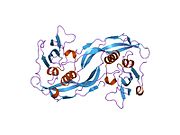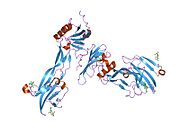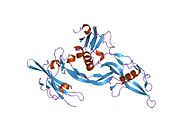Bone morphogenetic protein 2
Ensembl | |||||||||
|---|---|---|---|---|---|---|---|---|---|
| UniProt | |||||||||
| RefSeq (mRNA) | |||||||||
| RefSeq (protein) | |||||||||
| Location (UCSC) | Chr 20: 6.77 – 6.78 Mb | Chr 2: 133.39 – 133.4 Mb | |||||||
| PubMed search | [3] | [4] | |||||||
| View/Edit Human | View/Edit Mouse |
Bone morphogenetic protein 2 or BMP-2 belongs to the TGF-β superfamily of proteins.[5]
Function
BMP-2 like other
Like many other proteins from the BMP family, BMP-2 has been demonstrated to potently induce osteoblast differentiation in a variety of cell types.[7]
BMP-2 may be involved in white adipogenesis[8][9] and may have metabolic effects.[8][9]
Interactions
Bone morphogenetic protein 2 has been shown to
Clinical use and complications
Bone morphogenetic protein 2 is shown to stimulate the production of bone.
The use of dual tapered threaded fusion cages and recombinant human bone morphogenetic protein-2 on an absorbable collagen sponge obtained and maintained intervertebral spinal fusion, improved clinical outcomes, and reduced pain after anterior lumbar interbody arthrodesis in patients with degenerative lumbar disc disease.[18] As an adjuvant to allograft bone or as a replacement for harvested autograft, bone morphogenetic proteins (BMPs) appear to improve fusion rates after spinal arthrodesis in both animal models and humans, while reducing the donor-site morbidity previously associated with such procedures.[19]
A study published in 2011 noted "reports of frequent and occasionally catastrophic complications associated with use of [BMP-2] in spinal fusion surgeries", with a level of risk far in excess of estimates reported in earlier studies.[23][24] An additional review by Agrawal and Sinha of BMP-2 and its common delivery systems in early 2016 showed how "problems like ectopic growth, lesser protein delivery, [and] inactivation of the protein" reveal a further need "to modify the available carrier systems as well as explore other biomaterials with desired properties."[17]
References
- ^ a b c GRCh38: Ensembl release 89: ENSG00000125845 – Ensembl, May 2017
- ^ a b c GRCm38: Ensembl release 89: ENSMUSG00000027358 – Ensembl, May 2017
- ^ "Human PubMed Reference:". National Center for Biotechnology Information, U.S. National Library of Medicine.
- ^ "Mouse PubMed Reference:". National Center for Biotechnology Information, U.S. National Library of Medicine.
- PMID 2376592.
- S2CID 22932278.
- PMID 12168799.
- ^ PMID 16580992.
- ^ PMID 30609449.
- PMID 11263668.
- S2CID 30068719.
- PMID 10880444.
- PMID 10712517.
- S2CID 83951938.
- PMID 14623404.
- S2CID 45699304.
- ^ PMID 26728994.
- ^ PMID 19411467.
- ^ PMID 16732630.
- PMID 14737759.
- PMID 17092225.
- PMID 16164462.
- ^ Richter R (2011-06-28). "Medtronic's spinal fusion product shown to be harmful in bold review by medical journal and its Stanford editors". Inside Stanford Medicine. Stanford School of Medicine. Archived from the original on 2012-04-23. Retrieved 2012-06-25.
- PMID 21729796. Archived from the original(PDF) on 2011-11-10.
Further reading
- Nickel J, Dreyer MK, Kirsch T, Sebald W (2001). "The crystal structure of the BMP-2:BMPR-IA complex and the generation of BMP-2 antagonists". J Bone Joint Surg Am. 83-A Suppl 1 (Pt 1): S7–14. PMID 11263668.
- Kawamura C, Kizaki M, Ikeda Y (2002). "Bone morphogenetic protein (BMP)-2 induces apoptosis in human myeloma cells". Leuk. Lymphoma. 43 (3): 635–9. S2CID 42810021.
- Marie PJ, Debiais F, Haÿ E (2002). "Regulation of human cranial osteoblast phenotype by FGF-2, FGFR-2 and BMP-2 signaling". Histol. Histopathol. 17 (3): 877–85. PMID 12168799.
External links
- bone morphogenetic protein 2 at the U.S. National Library of Medicine Medical Subject Headings (MeSH)
- Human BMP2 genome location and BMP2 gene details page in the UCSC Genome Browser.







